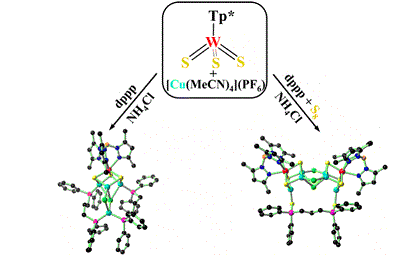†‡, §, †, †, §, *†(张文华), §, and *†‡ (郎建平)
† State and Local Joint Engineering Laboratory for Novel Functional Polymeric Materials, College of Chemistry, Chemical Engineering and Materials Science, Soochow University
‡ State Key Laboratory of Organometallic Chemistry, Shanghai Institute of Organic Chemistry, Chinese Academy of Sciences
§ School of Physical Science and Technology, Soochow University
Inorg. Chem., 2016, 55 (4), 1861–1871
In the absence/presence of S8, the one-pot assembly of [Et4N][Tp*WS3] [1; Tp* = hydridotris(3,5-dimethylpyrazol-1-yl)borate] with [Cu(MeCN)4]PF6 and bis- or tetraphosphine ligands 1,2-bis(diphenylphosphino)ethane (dppe), 1,3-bis(diphenylphosphino)propane (dppp), 1,4-bis(diphenylphosphino)butane (dppb), and N,N,N′,N′-tetrakis(diphenylphosphinomethyl)ethylenediamine (dppeda) produces six W–Cu–S clusters, namely, [(Tp*WS3Cu2Cl)2(dppe)] (2), [Tp*WS3Cu4(dppp)2(μ4-Cl)(μ-Cl)]PF6·MeCN (3·MeCN), [(Tp*WS3Cu3)2(μ4-Cl)(μ-Cl)2(dpppS2)] (4), [(Tp*WS3Cu2Cl)2(dppbS2)]·2MeCN·2H2O (5·2MeCN·2H2O), [(Tp*WS3Cu3Cl2)2(dppbS2)] (6), and [(Tp*WS3Cu3)2(Ph2PS2)3(μ6-Cl)0.5](PF6)0.5·0.75CH2Cl2 (7·0.75CH2Cl2). Compounds 2–7 are characterized by elemental analysis, IR, UV–vis, 1H and 31P{1H} NMR, electrospray ionization mass spectrometry, and X-ray crystallography. For 2, the dppe ligand bridges a pair of butterfly-shaped [Tp*WS3Cu2] cores to form a double-butterfly-shaped structure. For 4, the dppp ligand is susceptible toward S association and forms an in situ generated dpppS2 ligand, supporting an octanuclear double-half-open-cubane structure and contrasting an analogous system wherein a pentanuclear motorcycle-shaped cationic cluster 3 is formed with the absence of S8. A longer dppb ligand readily converts to S-based ligands in 5 and 6, subsequently serving as bridges between a pair of a butterfly-shaped (5) and nest-shaped (6) clusters. Further use of a tetraphosphine ligand, dppeda, in the cluster formation, with the presence of S8, leads to an unexpected ligand degradation to give the [Ph2PS2]− anions. Three [Ph2PS2]− anions juxtapose a pair of nest-shaped cluster cores to yield an octanuclear cluster, 7, featuring a cage to encapsulate μ6-Cl–. The third-order nonlinear-optical (NLO) properties of 2–7 in N,N-dimethylformamide, investigated using a Z-scan technique at 532 nm, show that 2–6 have a reverse saturable absorption, while 7 has a notable saturable absorption. All of 2–7 exhibit a self-focusing effect with hyperpolarizability γ values in the range of 4.71 × 10–30–1.02 × 10–29 esu, which are 440–1000 times higher than that of 1. The formation of 4–7 from 1 through the in situ thiolation of phosphine ligands presents a new approach to the design and assembly of the W–Cu–S clusters with interesting structural arrays and better NLO properties.

链接://pubs.acs.org/doi/abs/10.1021/acs.inorgchem.5b02765